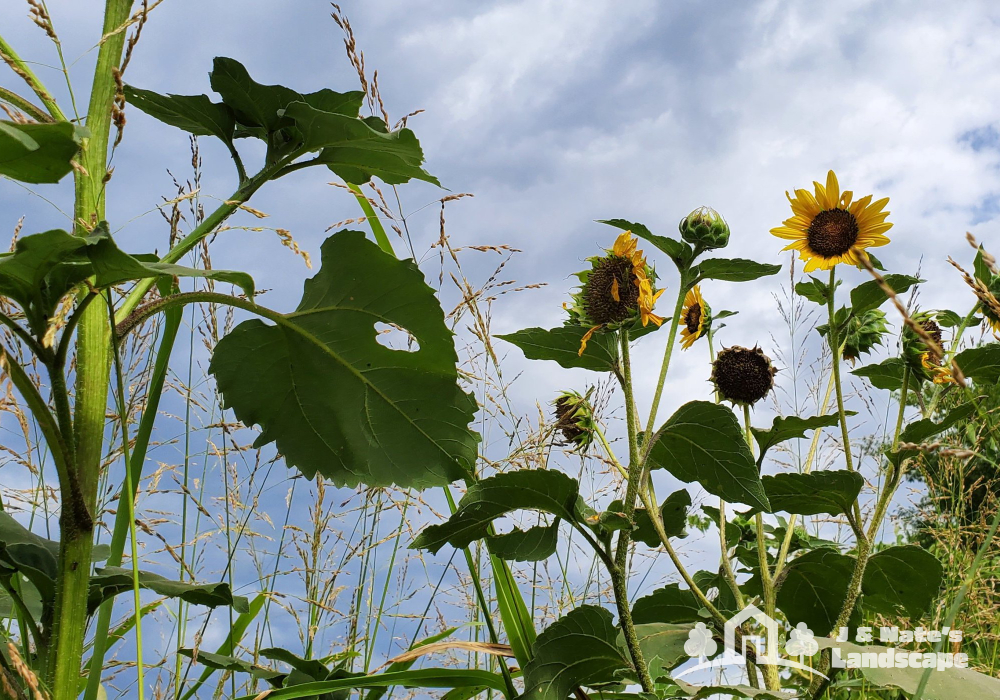This post contains Amazon affiliate links. If you click through and make a purchase, we may earn a commission, at no additional cost to you.
If you see a larger than usual community of grasshoppers on your property early in the year, there’s a good chance you’re looking at a drought for the summer. This is especially true in Oklahoma with the 130 species of grasshoppers that reside in our state — and we have seen evidence of it this year. Some of our rural clients are reporting that the grasshoppers have been really bad since July. At one house, we couldn’t walk two feet without grasshoppers bouncing in every direction. Then after clearing brush away from the side of their house, we discovered a dozen of them perched on the metal siding.
We’ve also noticed grasshoppers eating sunflower leaves and munching in people’s gardens.
Grasshoppers are voracious. They eat 16 times their body weight every single day! (There’s a reason they’re the bullies in A Bug’s Life!) This means that during drought conditions, when your gardens are already stressed, they move in from public range lands to private crops and gardens like your lettuce and carrot crops are their own personal buffet.
Don’t get us wrong — grasshoppers are an important part of our ecosystem since they serve as food for wildlife including wild turkeys, blue jays, blackbirds, bluebirds, and hawks. They are also eaten by domestic chickens.
So what can you do to get rid of the grasshoppers munching on your garden and hopping all over your property?
Well, if you live in a rural area, you could invest in chickens and guineas. These domestic animals also eat ticks and produce eggs. It’s a win win! However, if that’s out of the question, we suggest a few strategies to control them beginning in the fall or spring, deter grasshoppers from your property, or lure them elsewhere.

Control the grasshoppers
If it’s early enough in the season, you may also be able to use organic control methods such as Semaspore and Nolo Bait. These products are safe for children, pets, and the environment, but when applied in the spring, will infect and eliminate the grasshoppers. Sometimes, this method has even better results the following season.
Some Oklahoma gardeners also recommend food-grade diatomaceous earth, which is dust made from diatoms. Diatoms are tiny skeletons of ocean animals/plants with sharp edges that cut the soft body parts of insects or slugs that come in contact with them. These dust particles are too small to hurt people or pets. Gardeners have also recommended spraying watered-down jalapeno juice on your garden, as well.
You might also consider Monterey Garden spray concentrate with spinosad. This is a natural bacteria that kills the grasshoppers, but is safe for organic gardening.
Starting now, you may also want to setup a bird habitat, which includes nesting areas and a water source. Since many birds eat grasshoppers, providing them with a nice home near your garden will encourage them to snack on your abundance of grasshoppers. For the record, we can source a nice bird bath locally and deliver and install it.
We can help you choose and implement whichever control methods work best for your property and situation.

Deter the grasshoppers
Grasshoppers don’t like forsythia, verbena, and lilac, so we recommend planting them wherever you don’t want tons of grasshoppers. These make nice plants for landscaping around your home or the fences around your yard. Both verbena and lilac also produce floral scents that you can catch on a warm summer evening breeze.
We also recommend you plant marigolds, calendula, sunflower, aster, alyssum, or dill in your garden to attract beneficial insects. Robber flies, spiders, and toads are natural predators of grasshoppers and can keep them under control.
Other plants in your garden that can deter grasshoppers include squash, peas, and tomatoes.
We can help you evaluate your property, determine the best places to plant your deterrents, source and install them them.

Lure the grasshoppers away
You may also lure grasshoppers away from your home and gardens by planting crops they love as far away on your gardens and home as you can. These trap crops include tall grasses like Timothy grass or crops like corn, wheat, or rye. These grasshopper buffets will keep the hungry insects out of your green beans and grape vines.
If you’d like us help you create a grasshopper free landscape on your property, schedule a consultation so we can prepare a landscaping plan for the fall planting season or spray for prevention in the spring.
